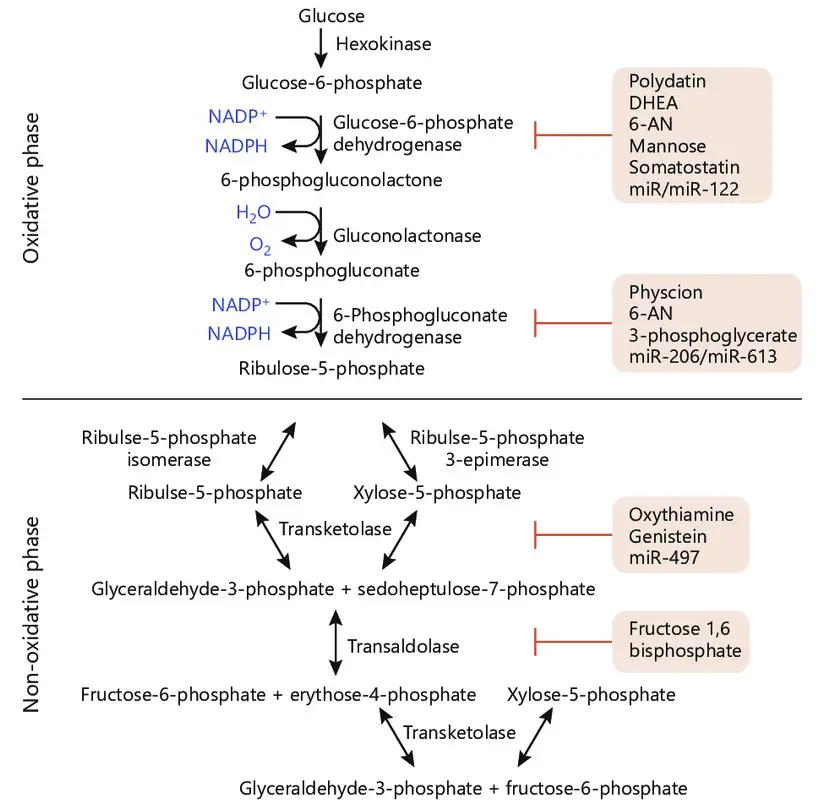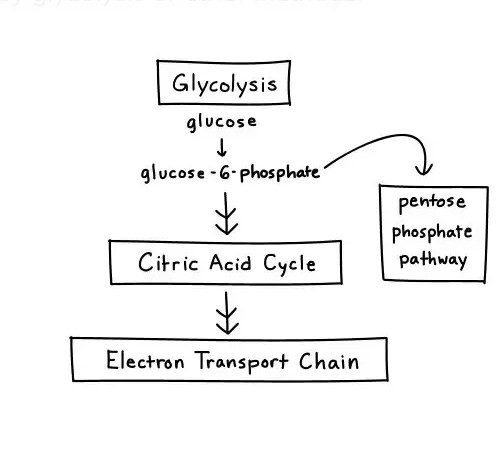Metabolism is a fundamental aspect of biological life, central to how cells process nutrients and generate energy. Within the broader realm of metabolic pathways, the Pentose Phosphate Pathway (PPP) plays a critical role, yet it is less well-known than processes like glycolysis or the citric acid cycle. This pathway not only assists in energy metabolism but also in the biosynthesis of nucleotides and the maintenance of cellular redox balance.
The Pentose Phosphate Pathway is divided into two distinct phases: the Oxidative and the Nonoxidative pathways. The Oxidative phase is crucial for its production of NADPH, used in reductive biosynthesis and antioxidant defense. Conversely, the Nonoxidative phase provides ribose-5-phosphate for nucleotide synthesis and can interconvert sugar molecules to feed into other metabolic pathways.
While both parts of the PPP are essential for cellular function, they differ significantly in their enzymatic activities, products, and roles within the cell. The Oxidative pathway generates ribulose-5-phosphate and NADPH, while the Nonoxidative pathway mainly produces ribose-5-phosphate and links to glycolysis and gluconeogenesis through its diverse range of sugar phosphates.

Basic Concepts
What is Metabolism?
Metabolism encompasses all the chemical reactions that occur within a living organism to maintain life. These processes are crucial for the conversion of food into energy for cellular processes, the synthesis of necessary compounds, and the elimination of waste products. Metabolism can be broadly divided into two categories:
- Catabolism: This is the breakdown of molecules to obtain energy.
- Anabolism: This involves the synthesis of all compounds needed by the cells.
Role of Pentose Phosphate Pathway
The Pentose Phosphate Pathway (PPP) serves two primary purposes within the cell’s metabolism:
- Production of NADPH: Essential for reductive biosynthesis, allowing cells to build fatty acids and nucleic acids.
- Synthesis of Ribose Sugars: Critical for the production of nucleotides and nucleic acids.
The PPP is thus fundamental not only in providing the necessary ingredients for DNA and RNA but also in protecting the cell against oxidative stress by supplying reducing power.
Oxidative Pathway
Key Features
The Oxidative Pentose Phosphate Pathway is marked by its ability to generate NADPH and ribose-5-phosphate. Its primary functions include:
- NADPH Production: Vital for antioxidative functions and anabolic reactions.
- Ribulose-5-Phosphate Production: Acts as a precursor for nucleotide synthesis.
Main Enzymes
The enzymes that play pivotal roles in the Oxidative PPP include:
- Glucose-6-phosphate dehydrogenase (G6PD): Catalyzes the conversion of glucose-6-phosphate into 6-phosphoglucono-δ-lactone, producing NADPH.
- 6-phosphogluconolactonase: Converts 6-phosphoglucono-δ-lactone into 6-phosphogluconate.
- 6-phosphogluconate dehydrogenase: Further processes 6-phosphogluconate into ribulose-5-phosphate, generating another molecule of NADPH.
Biochemical Steps
The biochemical steps involved in the Oxidative pathway include:
- Oxidation of Glucose-6-phosphate: This reaction is catalyzed by G6PD and results in the formation of 6-phosphoglucono-δ-lactone.
- Hydrolysis: 6-phosphoglucono-δ-lactone is hydrolyzed to 6-phosphogluconate.
- Decarboxylation: The final step, catalyzed by 6-phosphogluconate dehydrogenase, produces ribulose-5-phosphate.
Products and Outputs
The Oxidative phase of the PPP results in:
- NADPH: Used for reductive biosyntheses and in maintaining the antioxidant status of the cell.
- Ribulose-5-Phosphate: Can be utilized to generate ribose-5-phosphate for nucleotide synthesis or converted to xylulose-5-phosphate for other metabolic pathways.
Nonoxidative Pathway
Core Characteristics
The Nonoxidative Pentose Phosphate Pathway is characterized by its versatility in sugar interconversions. It primarily deals with the rearrangement and conversion of sugars generated by the Oxidative phase into forms usable by other metabolic pathways.
Enzymatic Actions
Key enzymes in this phase include:
- Transketolase: Transfers two-carbon units.
- Transaldolase: Transfers three-carbon units.
These enzymes help in the reshuffling of carbon atoms among sugar molecules, which is essential for maintaining a balance of metabolic intermediates.
Reaction Sequence
The sequence of reactions in the Nonoxidative pathway involves:
- Transketolase Reaction: Transfers a two-carbon unit from a ketose donor to an aldose acceptor.
- Transaldolase Reaction: Shifts a three-carbon unit from a ketose donor to an aldose acceptor.
- Further Transketolase Reaction: Another two-carbon unit is transferred to adjust the sugar backbones as needed.
End Products
The primary outputs from the Nonoxidative pathway include:
- Ribose-5-Phosphate: Necessary for nucleotide and nucleic acids synthesis.
- Erythrose-4-Phosphate and Xylulose-5-Phosphate: Feed into glycolysis or other metabolic routes, such as aromatic amino acid synthesis.
Comparative Analysis
Similarities Between Pathways
Both the Oxidative and Nonoxidative Pentose Phosphate Pathways play integral roles in cellular metabolism, but share several key similarities:
- Dependency on Glucose-6-Phosphate: Both pathways commence with glucose-6-phosphate derived from the glycolytic pathway.
- Contribution to Cellular Biosynthesis: Each pathway contributes essential intermediates for nucleotide and nucleic acid synthesis, underscoring their critical role in cell growth and maintenance.
- Regulation: Both branches are regulated by the cellular demand for NADPH and the intermediates they generate, ensuring that metabolic fluxes are adjusted according to cellular needs.
Differences: Enzymatic, Functional
Despite their similarities, the pathways exhibit distinct differences:
Enzymatic Differences
- Specific Enzymes: The Oxidative pathway utilizes enzymes like glucose-6-phosphate dehydrogenase for the oxidation reactions, while the Nonoxidative phase relies on enzymes such as transketolase and transaldolase for sugar rearrangements.
Functional Differences
- End Products: The primary end product of the Oxidative pathway is NADPH, crucial for anabolic reactions and detoxification. Conversely, the Nonoxidative pathway primarily rearranges molecules to facilitate other metabolic processes without producing NADPH.
- Reversibility: The Nonoxidative pathway is reversible, allowing greater flexibility in response to metabolic demands compared to the irreversible Oxidative pathway.
Biological Significance
Cellular Functions
The Pentose Phosphate Pathway supports several fundamental cellular functions:
- Redox Balance: NADPH produced by the Oxidative pathway is vital for maintaining the redox balance within the cell, protecting against oxidative damage.
- Synthetic Pathways: Ribose-5-phosphate is a precursor for DNA and RNA synthesis, pivotal during cell division and growth.
- Metabolic Flexibility: The Nonoxidative pathway enhances metabolic flexibility, enabling the cell to produce a variety of sugars that can be utilized in multiple pathways depending on the cell’s needs.
Health Implications
Aberrations in the PPP have profound health implications:
- Glucose-6-phosphate dehydrogenase deficiency, commonly known as G6PD deficiency, can lead to hemolytic anemia due to reduced NADPH levels, affecting red blood cell integrity.
- Cancer cells often exhibit increased PPP activity to support rapid proliferation by supplying abundant NADPH and ribose-5-phosphate for anabolic growth.
Applications and Implications
Clinical Relevance
Understanding the PPP’s mechanisms is crucial for clinical applications:
- Targeting Cancer: Inhibiting PPP enzymes offers a potential strategy for starving cancer cells of the necessary components for rapid growth.
- Managing Oxidative Stress: Enhancing the Oxidative pathway could be beneficial in treating diseases related to oxidative stress, such as diabetes and cardiovascular diseases.
Research and Future Prospects
The ongoing research into the PPP promises to unveil new therapeutic strategies and diagnostic tools:
- Gene Therapy: Research into overexpressing PPP enzymes could lead to new gene therapy techniques for diseases caused by enzyme deficiencies.
- Biomarkers: PPP activity levels could serve as biomarkers for certain cancers, helping in early diagnosis and personalized treatment plans.
Frequently Asked Questions
What is the Pentose Phosphate Pathway?
The Pentose Phosphate Pathway (PPP) is a metabolic pathway parallel to glycolysis. It serves two primary functions: generating NADPH for reductive reactions and synthesizing ribose sugars for nucleic acid production. It plays a vital role in maintaining cellular redox balance and supporting rapid cell growth.
How does the Oxidative phase differ from the Nonoxidative phase?
The Oxidative phase of the PPP is characterized by its production of NADPH and ribulose-5-phosphate, involving the oxidation of glucose-6-phosphate. The Nonoxidative phase, in contrast, focuses on rearranging these products into other sugars like ribose-5-phosphate and xylulose-5-phosphate, which are useful for nucleotide synthesis and metabolic interconversions.
What are the main enzymes involved in the PPP?
The main enzymes of the Oxidative phase include glucose-6-phosphate dehydrogenase and 6-phosphogluconolactonase, which help catalyze the conversion of glucose-6-phosphate into ribulose-5-phosphate and NADPH. In the Nonoxidative phase, enzymes like transketolase and transaldolase play significant roles in sugar transformations and synthesis pathways.
Why is the Pentose Phosphate Pathway important for cells?
The PPP is crucial for cells because it supplies NADPH needed for fatty acid synthesis and maintaining the antioxidant system. Additionally, it provides ribose-5-phosphate for nucleotide and nucleic acid synthesis, supporting DNA and RNA production essential for cell growth and division.
Conclusion
The Pentose Phosphate Pathway is integral to cellular metabolism, providing critical components for anabolic reactions and maintaining overall cellular health. Its dual phases offer versatility in metabolic regulation, ensuring cells adapt to various metabolic demands. This pathway underscores the intricate balance of energy production, biosynthesis, and antioxidant protection within cells.
Understanding the nuances between the Oxidative and Nonoxidative phases of the PPP allows researchers and clinicians to better appreciate how cells manage chemical energy and synthesize crucial biomolecules. As research continues, the knowledge of PPP’s mechanisms and functions will undoubtedly expand, offering new insights into cellular metabolism and potential therapeutic targets.

